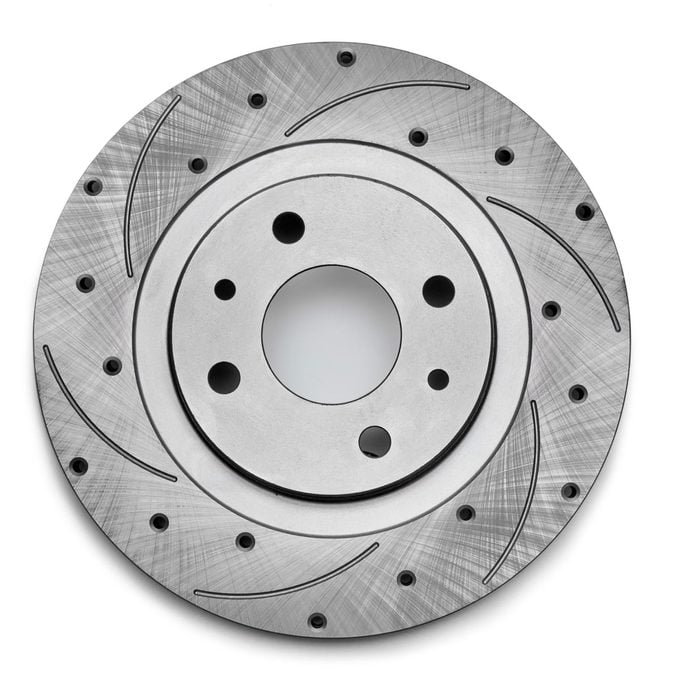What You Need to Know About Brake Rotors
Updated: Dec. 18, 2021
Brake rotors and brake calipers stop your car in a disc brake system. What are rotors made of and how do differences in rotors affect performance?

As the differentiating component of disc brakes, brake rotors play a central role in stopping your car. Here’s what you should know about them.
How Brake Rotors Work
In a disc-brake system, rotors attach to the axle, usually sliding over the lugs that also secure the wheel to the hub. They provide a contact surface for the brake pads, which, under load, generates friction, converts kinetic energy to heat, and slows the vehicle. The advantage gained with a rotor lies in its flat, plate-like shape with braking surfaces on both sides. The squeezing action supplied by the brake caliper (which straddles the rotor’s edge and holds the pads in place) requires less force to slow the vehicle than other hydraulic systems. Rotors also work to dissipate the heat generated while braking.
Change your own brake rotors with these tips.
Material Choice
The vast majority of brake rotors are cast iron. You can find them made from a handful of other materials: steel (better cooling, prone to warping), layered steel (warp-resistant, more expensive), aluminum (lighter, melt easier), high-carbon (high-performance, expensive) and ceramic (top-end performance cars, such as, Ferrari). The performance of these other materials greatly exceeds the demands of normal driving conditions and in nearly all cases do not justify the added expense. Coatings improve rotor cosmetics, adding color to non-braking surfaces and protecting against rust, but coatings do not improve braking performance.
Check out these tips for optimizing brake performance.
Features Found on Rotors
Other brake rotor features include venting, slotting and either cross-drilling or dimpling. Rotors can be solid or vented (pictured above), where the former look like one solid plate and the latter, two separated plates connected by a series of ribs. The difference between the two lies only in the vented rotor’s increased ability to dissipate heat. Because of the significant difference in thickness, they are generally not interchangeable.
Slotted rotors give up some surface area and mass (friction potential and heat absorption) to vent gasses and pad dust away from the point of contact. Under heavy braking, these materials can interfere with contact between the pad and rotor and reduce performance. If you choose slotted rotors, however, keep an eye on your pads anyway. Some slotted rotors can accelerate pad wear.
Can you recognize these auto parts by their British names?
Cross-drilled rotors, originally developed for racing cars, deliver better cooling and extend pad life. Drilling holes all the way through the rotors, however, puts them at risk for cracking under extreme temperatures, so slotted rotors now rule on the track. Everyday drivers never generate that kind of heat, but you’ll still see cross-drilled rotors around town. Their advantage comes when things get wet. Water escapes the rotor surface through the holes and allows the pad a better bite. Dimpled rotors provide similar gas-dissipation properties without the potential for cracking, but do not handle wet surfaces as well as cross-drilled rotors.
If you often haul or tow heavy loads, a slotted and cross-drilled rotor offers the best performance. These rotors maintain a clean braking surface while minimizing temperature. A win-win for this driving situation.
Check out this collection of tips for getting better gas mileage now.
About Changing Rotors
As mentioned, managing heat is a primary task for brake rotors and it takes some heavy metal to accomplish that. Escalating fuel-economy demands finally began affecting rotors in recent years as manufacturers have reduced the amount of material rotors contain. Before 2015, shops and DIYers commonly machined rotors to restore the braking surface and remounted them. Consider today’s rotors disposable. If you can still find an outlet that turns rotors, they will measure the thickness for you, to make sure they stay within specifications, and let you know when it’s time to replace.
When changing rotors, don’t forget to save and re-use the rubber plug that many rotors (particularly rear rotors) contain. It allows access to the adjustment screw for the parking brake and does not come with new rotors.
